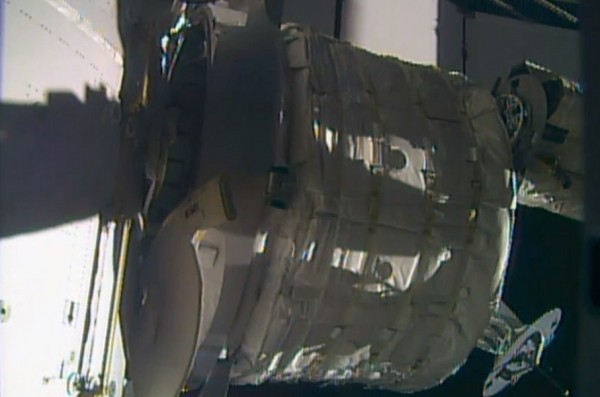Expandable Space Habitat Fails to Inflate at Space Station
| Ana Verayo | | May 27, 2016 06:12 AM EDT |
(Photo : NASA TV) The Bigelow Expandable Activity Module (BEAM) was installed on the International Space Station April 16, 2016.
NASA's first attempt to inflate an expandable space habitat in space was unfortunately met with some technical glitches, as it completely failed launch.
Known as BEAM (Bigelow Expandable Activity Module), the test for yesterday was postponed after trying to pump air into the BEAM which lasted for several hours at the International Space Station.
Like Us on Facebook
According to NASA officials, engineers are now meeting at the Johnson Space Center in Houston for another approach to the Bigelow Expandable Activity Module. By evaluating data from this first expansion attempt, if this data can support the resumption of operations, another attempt will be carried out as early as tomorrow.
This inflatable space habitat is the first to be tried in real microgravity conditions, that was transported by the SpaceX Dragon capsule. Before yesterday's inflation attempt, astronauts prepared the Tranquility module of the space station where they attached this inflatable room. BEAM measures around 10 feet in diameter and 13 feet in length, reveals NASA.
NASA aims to use BEAM as a crucial part of the station and also as a developing technology for long term, manned space missions across space especially to Mars.
First developed by private space company, Bigelow Aerospace in the 1990s, this space habitat with expandable technology, can be a crucial step in exploring deep space, especially Mars and beyond, where astronauts will need habitats that are both durable, easier to transport and assemble.
When the BEAM space habitat will be successfully inflated on the second attempt at the International Space Station, astronauts will proceed to inspect this new room for several hours, in order to collect the necessary data and investigate the room's conditions, as this experiment is expected to last for two years.
For two years, the airlock between BEAM and the space station will remain closed and sealed tightly shut. There will also be BEAM sensors to keep track of the temperature inside along with radiation levels, and to also monitor how this inflatable space habitat will be able to withstand potential space debris. Apart from this, BEAM is also designed to slowly deflate so that it would not impose any dangers to the space station and also for astronauts to pack up easier.
TagsBeam, expandable space habitat, ISS, International Space Station, NASA, artificial space habitat, inflatable space habitat
©2015 Chinatopix All rights reserved. Do not reproduce without permission
EDITOR'S PICKS
-

Did the Trump administration just announce plans for a trade war with ‘hostile’ China and Russia?
-

US Senate passes Taiwan travel bill slammed by China
-

As Yan Sihong’s family grieves, here are other Chinese students who went missing abroad. Some have never been found
-

Beijing blasts Western critics who ‘smear China’ with the term sharp power
-

China Envoy Seeks to Defuse Tensions With U.S. as a Trade War Brews
-

Singapore's Deputy PM Provides Bitcoin Vote of Confidence Amid China's Blanket Bans
-

China warns investors over risks in overseas virtual currency trading
-

Chinese government most trustworthy: survey
-

Kashima Antlers On Course For Back-To-Back Titles
MOST POPULAR
LATEST NEWS
Zhou Yongkang: China's Former Security Chief Sentenced to Life in Prison

China's former Chief of the Ministry of Public Security, Zhou Yongkang, has been given a life sentence after he was found guilty of abusing his office, bribery and deliberately ... Full Article
TRENDING STORY

China Pork Prices Expected to Stabilize As The Supplies Recover

Elephone P9000 Smartphone is now on Sale on Amazon India

There's a Big Chance Cliffhangers Won't Still Be Resolved When Grey's Anatomy Season 13 Returns

Supreme Court Ruled on Samsung vs Apple Dispute for Patent Infringement

Microsoft Surface Pro 5 Rumors and Release Date: What is the Latest?










